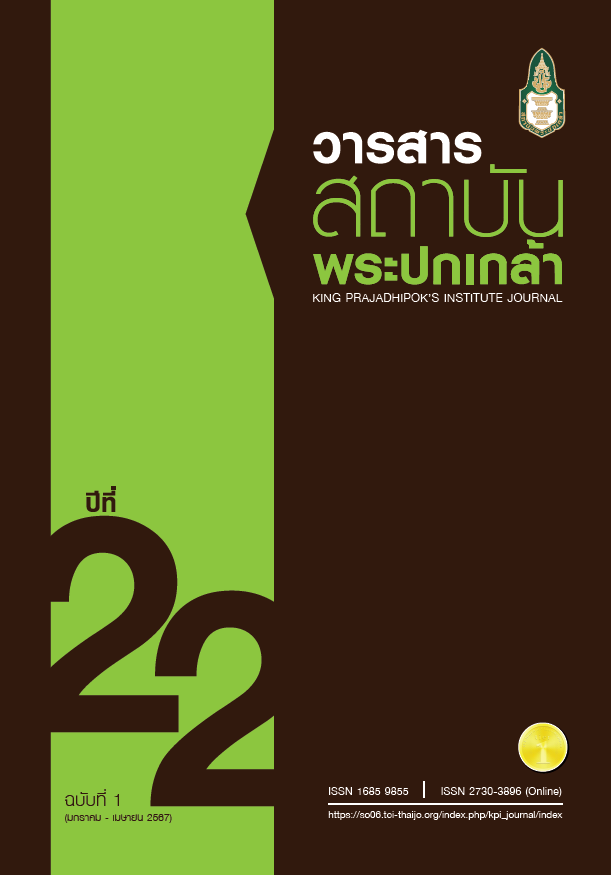Ways to Improve the Index and Process of ITA
Main Article Content
Abstract
ITA is an important mechanism to prevent public sector corruption and is assigned to national strategies to fight corruption and evaluate the transparency and quality of public services provided by government organizations. This research paper studied ITA's principles, indexing process, and implications of ITA and gave recommendations for improving ITA. In-depth interviews were conducted with senior executives, employees of government organizations, and other key informants relevant to ITA. The results revealed that ITA can partially evaluate the transparency and performance of an organization. The Internal Integrity and Transparency Assessment (IIT) and External Integrity and Transparency Assessment (EIT) are used to assess the perceptions of the organization's stakeholders about its performance, which can vary from time to time. IIT and EIT should not be designed to evaluate different types of government organizations. The Open Data Integrity and Transparency Assessment (OIT), which evaluates the level of public information disclosure, emphasizes the quantitative components of information rather than its quality and usability. In addition, ITA also needs help in terms of the data collection process, which impacts the credibility of the assessment. It is recommended that the National Anti-Corruption Commission rewrite IIT and EIT questions to be more straightforward and more understandable, define the unit of analysis in the questions, and design different sets of questions for different government organizations.
Moreover, the Commission should set up a central unit to set proportions for respondents, who should come from various departments. OIT questions should consider the quality and details of information that is disclosed. It should be scaled 0-100, the same as IIT and EIT. The weight of IIT, EIT, and OIT should be recalculated to 33%, 33%, and 33%, respectively, and the scores should add up to 100 points. In addition to IIT, EIT, and OIT, the Commission should consider other qualitative information, such as observing the data collection period to increase the transparency in ITA, which will be used as an effective tool to evaluate an organization's performance.
.
Article Details

This work is licensed under a Creative Commons Attribution-NonCommercial-NoDerivatives 4.0 International License.
@ 2020 King Prajadhipok's Institute The Government Complex Commemorating All Right Reserved.
References
ภาษาไทย
แผนการปฏิรูปประเทศ (ฉบับปรับปรุง). (2564, 25 กุมภาพันธ์). ราชกิจจานุเบกษา. เล่ม 138 ตอนพิเศษ 44 ง. น. 271-291.
พระราชบัญญัติประกอบรัฐธรรมนูญว่าด้วยการป้องกันและปราบปรามการทุจริต พ.ศ. 2561. (2561, 21 กรกฎาคม). ราชกิจจานุเบกษา. เล่ม 135 ตอนที่ 52 ก. น. 15-22.
สำนักงานคณะกรรมการป้องกันและปราบปรามการทุจริตแห่งชาติ. (2565ก). คู่มือการประเมินคุณธรรมและความโปร่งใสในการดําเนินงานของหน่วยงานภาครัฐ (Integrity and Transparency Assessment: ITA) ประจำปีงบประมาณ พ.ศ. 2565. กรุงเทพฯ: บริษัท กรังด์ปรีซ์ อินเตอร์เนชันแนล จำกัด (มหาชน).
สำนักงานคณะกรรมการป้องกันและปราบปรามการทุจริตแห่งชาติ. (2565ข). รายงานผลการประเมินคุณธรรมและความโปร่งใสในการดําเนินงานของหน่วยงานภาครัฐ (Integrity and Transparency Assessment: ITA) ประจำปีงบประมาณ พ.ศ. 2565. กรุงเทพฯ: บริษัท กรังด์ปรีซ์ อินเตอร์เนชันแนล จำกัด (มหาชน).
สำนักงานคณะกรรมการป้องกันและปราบปรามการทุจริตแห่งชาติ. (2566). การแถลงข่าวประกาศผลการประเมิน ITA ประจำปี 2566 (ITA DAY 2023: Growth & Goals เติบโตสู่เป้าหมาย) [วิดีโอ]. YouTube. สืบค้นจาก https://www.youtube.com/watch?v=4oU86TZ9X2Q
สำนักงานวิจัยแห่งชาติ. (2563). รายงานผลการประเมินคุณธรรมและความโปร่งใสการดำเนินงานของหน่วยงานภาครัฐ (Integrity and Transparency Assessment : ITA) ปีงบประมาณ 2563 และการวิเคราะห์ผลประเมินคุณธรรมและความโปร่งใสการดำเนินงานของหน่วยงานภาครัฐ. กรุงเทพฯ: ศูนย์ปฏิบัติการต่อต้านการทุจริต.
ภาษาอังกฤษ
Transparency International. (2021). Corruption Perceptions Index 2021. Retrieved from https://www.transparency.org/en/cpi/2021/index/tha
Transparency International. (2022). Corruption Perceptions Index 2022. Retrieved from https://www.transparency.org/en/cpi/2022/index/tha


